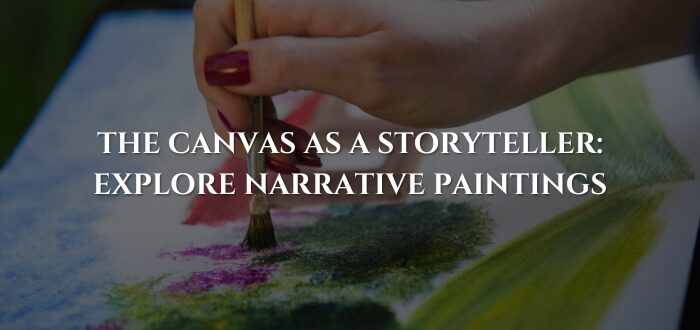The Canvas As A Storyteller: Explore Narrative Paintings
The world of visual arts and paintings is filled with colours and bold patterns, each trying to convey a narrative. Be it a Madhubani folktale painting, a miniature painting or even a modern abstract work, each of these paintings is a gateway to another world. The art of storytelling in painting is a timeless tradition that has captivated audiences for centuries. At its core, narrative painting is about conveying a story or message through visual art. From cave walls to grand palace murals, visual art has been humanity’s earliest storyteller. Preserving folktales through art, artists across eras and civilizations have shared myths, chronicled history, and captured cultural identity. Today, as these paintings fade and modern media emerges, preserving narrative art has never been more important. This blog dives into the techniques of storytelling in ancient paintings, how Indian visual folk painting and storytelling use composition, symbolism, and form to convey deep narratives, and why safeguarding them is essential.

What Is Narrative in Painting?
Narrative in painting refers to the use of visual elements to tell a story, communicate a message, or evoke an emotional response. Artists achieve this through composition, colour, symbolism, metaphor, and gesture. A narrative painting might depict a historical event, a mythological scene, a personal memory, or an entirely fictional story, inviting viewers to interpret and connect with the imagery on a deeper level.
Art as Storytelling: Giving Life to Folklore
Since the dawn of civilization, human beings have told stories through words, symbols and paintings. Storytelling in painting is not a modern invention—it’s a practice rooted deep in our cultural DNA. Symbols, patterns, and colours have all been used to depict daily life, historic moments, mythological tales and cultural identity. From the hieroglyphs in tombs of Egypt to cave art in India, paintings as visual art have served as achievements of civilization.
These early artworks:
- Conveyed Mythological Tales: Gods, spirits, celestial beings, and ancestral heroes populated early visual narratives, offering moral lessons and spiritual guidance.
- Passed Down Moral Lessons: Imagery became a medium for transmitting oral histories, folklore, and communal wisdom across generations.
- United Communities: Storytelling art became a visual language understood across ages and regions, bonding people through common themes and symbols.
In this form of expression, colours, patterns, and motifs functioned as a coded visual language. A particular animal might symbolize courage, a recurring symbol could signify good fortune, while a pattern might represent unity or rebirth. These artistic elements weren’t merely aesthetic—they were carriers of meaning, linking the viewer to a deeper cultural identity.
Examples of Narrative Paintings In History

Narrative painting has played a pivotal role in the history of art, serving as a medium through which artists tell stories, depict events, or convey deep emotional and cultural messages.
Here are some notable examples:
- The Bayeux Tapestry (11th century)
A 70-meter-long embroidered cloth that chronicles the events leading up to the Norman Conquest of England in 1066. It’s one of the most detailed visual narratives of medieval warfare and politics.
- The Education of Achilles by the Centaur Chiron
A hallmark of 19th-century French Neoclassical painting, this monumental oil on canvas by Auguste-Clément Chrétien stands as one of the most significant works in the artist’s distinguished career. The composition captures a pivotal moment from Greek mythology—the early education of Achilles under the guidance of the centaur Chiron, revered as the “wisest of all the centaurs.”
- The Scream (1893) by Edvard Munch
While not a literal narrative, this expressionist masterpiece visually tells an emotional story—capturing a moment of intense psychological turmoil and existential dread.
- Pattachitra Scrolls from Odisha
These traditional cloth-based scrolls feature sequential panels depicting mythological stories—especially of Lord Jagannath, Krishna, and Ramayana scenes.
- Bhimbetka Rock Shelters (Madhya Pradesh, 30,000 BCE – 1000 CE)
Recognized as a UNESCO World Heritage Site, the Bhimbetka caves contain some of the oldest known human-made art in South Asia.
Also Read: Famous Indian Mythological Paintings
Indian Visual Storytelling: Painting Forms
India’s storytelling traditions are incredibly diverse, rich in style, theme, and regional identity. From divine epics to village life scenes, Indian painting traditions reflect centuries of narrative innovation.
-
Miniature Paintings
Originating in the courts of South India, these paintings combine jewel-like colours, gold leaf, and religious storytelling. They commonly depict Hindu epics like the Ramayana and Mahabharata, with gods like Vishnu, Krishna, and Shiva central to the narrative.
Also Read: Miniature Masterpieces: India’s Iconic Art
2. Madhubani Art
Practiced by women in Bihar for centuries, Madhubani art uses bold outlines, symmetrical designs, and vibrant natural pigments. The stories range from Sita’s wedding to local legends, harvest festivals, and spiritual beliefs—all captured within dense, decorative borders.
3. Pattachitra

These Odisha and Bengal-based scroll paintings unfold like storybooks. Each panel is a scene from a narrative, usually focused on Jagannath deities, Krishna’s life, or folk myths. During festivals, bards would sing and unroll the scrolls, creating a multimedia performance.
4. Kalighat Painting
Born in 19th-century Kolkata, Kalighat paintings were urban, satirical, and bold. While rooted in Hindu mythology, they also critiqued colonialism and corruption, creating a unique blend of narrative art and social commentary.
5. Warli Art
From the tribal communities of Maharashtra, Warli paintings use minimalistic forms to narrate village life—marriages, farming, festivals—creating a rhythmic, communal story using simple white patterns on mud backgrounds.
Storytelling in Indian Narrative Paintings
-
Panel Sequences
Many Indian narrative styles, especially scroll-based ones like Pattachitra, unfold scenes one after another, helping viewers “read” a story from left to right or top to bottom.
-
Iconography & Symbolism
Gestures (mudras), postures, animals, and plants are infused with meaning. For instance, four arms may signify divine power, while a peacock may reference Kartikeya or beauty.
-
Vivid Colour Palettes
Natural pigments like indigo, turmeric, red clay, and lamp black not only beautify the painting but evoke emotion and context—red for marriage and fertility, black for evil or protection.
-
Flat Perspective & Visual Hierarchy
Indian storytelling art typically avoids the Western linear perspective. Instead, space is used symbolically. Size, alignment, and placement indicate significance rather than realism.
-
Text + Image Integration
Scrolls and manuscripts often include handwritten verses or captions, guiding the narrative. This combination of visual and textual storytelling adds context and depth.
Preserving Narrative Paintings

Preserving narrative art is more than conserving ancient canvases—it’s about keeping cultural memory alive. Through visual storytelling in painting, artists have chronicled myths, rituals, everyday life, and collective identity for centuries. From prehistoric cave art to intricate folk scrolls, these works are living testaments to our shared history. Today, as modernization threatens to erase these traditions, it’s crucial to support the artists who continue practicing and evolving these forms. Whether through patronage, education, or digital platforms, investing in these creators ensures that ancient storytelling through painting remains not just a relic of the past but a vibrant, evolving tradition.
Where Visual Stories Live Forever
Paintings aren’t just to be seen—they’re to be read, felt, and remembered. In the Indian subcontinent and across the world, storytelling through painting continues to preserve the pulse of civilization. These images are time-travel devices—transporting us to sacred forests, royal courts, village weddings, and celestial battles.
By learning from ancient techniques, supporting traditional artists, and welcoming modern expressions, we ensure these painted stories remain vibrant—not just as relics of the past, but as living, breathing art forms that speak across generations.
So next time you stand before a narrative painting, look beyond the colour—listen to the story.






